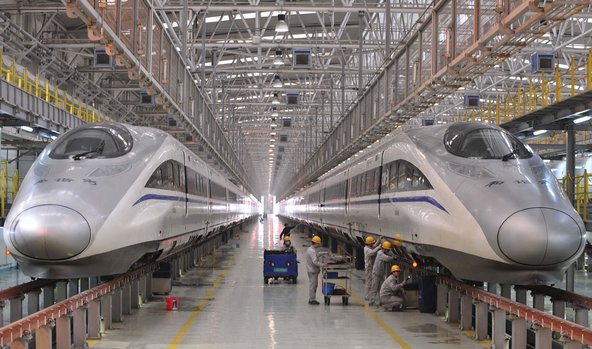New York and Chicago Railroad
Low U.S. Rail Spending Leads to Poor Safety, Experts Say
By NICOLA CLARKMAY 20, 2015 New York Times
China has opened more miles of high-speed rail since 2008 than all other countries combined. Credit China
PARIS — Across Europe and East Asia, hundreds of millions of train passengers a year are routinely whisked, at speeds that often exceed 200 miles an hour, over extensive rail networks that, for many, present a more reliable and affordable long-distance alternative than even air travel.
So the fatal derailment of an Amtrak train last week in Philadelphia that was traveling at half that speed surprised many outside North America, where railway accident rates have declined steadily to levels that now rival those of the world’s safest airlines.
In the aftermath of the wreck, and apart from House Speaker John A. Boehner’s dismissal of a question about railway funding as “stupid,” analysts say that if there is one lesson from abroad for preventing accidents like last week’s, it is this: You get what you pay for.
By a global standard, the United States has not been paying much. For the size of its economy, it lags far behind many of the world’s most developed countries in spending on rail networks.
As a consequence, industry experts say, the United States has among the worst safety records despite having some of the least-extensive passenger rail networks in the developed world. Fatality rates are almost twice as high as in the European Union and countries like South Korea, and roughly triple the rate in Australia.
Analysts say the impressive safety record in Europe and Asia is a result of steady government spending of billions of dollars on development and maintenance of railroad infrastructure, including sophisticated electronic monitoring and automated braking systems developed over the past 20 years.
“You can absolutely see the level of investment in the network coming through in the annual statistics,” said Christopher Irwin, vice chairman of the European Passengers’ Federation, a passenger advocacy group based in Belgium.
“Constant investment, constant improvement is the driving thing,” he added.
According to the International Transport Forum of the Organization for Economic Cooperation and Development, the United States invested less than 0.1 percent of its gross domestic product in rail systems in 2013, a quarter of what was spent by Britain and one-sixth of the investments by France and Australia.
Over the past decade, even developing countries, including India, Russia and Turkey, have consistently spent far greater shares of their G.D.P. on rail.
Per capita, the United States also comes up short. In 2011, the most recent year for which comparative statistics are available, it spent roughly $35 per person on all rail infrastructure.
The House Appropriations Committee this month knocked back President Obama’s $2.45 billion request for Amtrak for the coming fiscal year to $1.1 billion. That would be $251 million below the current funding level. The transportation spending bill that funds Amtrak will reach the House floor early next month, and a fight on rail spending is assured.
By comparison, Japan spent nearly three times as much as the United States — more than $100 per person — with the 28 member countries of the European Union investing similar sums.
In terms of safety, the return on that investment has been clear. Japan’s famous Shinkansen “bullet train” network has never experienced a fatal crash or derailment in 51 years of operation. The same can be said of France’s gleaming fleet of high-speed TGVs, which have zipped across the French countryside for more than three decades.
Even in Spain and China, the sites of two crashes in recent years where dozens were killed, overall rail accident rates per number of passengers remain among the lowest in the world.
“To maintain passenger networks on the scale of Europe or Japan requires large-scale spending of public money,” said Stephen Perkins, the head of research for the International Transport Forum.
In Europe, Mr. Perkins said, governments allocated large amounts of land to passenger rail networks in the 19th century. These were then continually expanded and modernized with support from taxpayers amid a public recognition of their economic and social value.
The development of United States infrastructure, meanwhile, was centered on road transport. “In a way, it is a kind of historical accident,” Mr. Perkins said. “If you have the lines there already from an earlier period, you can just carry on supporting and improving them.
“But putting that kind of rail access in retroactively is very expensive.”
Their more consistent upkeep of rail systems has allowed European and Asian countries to devote a growing share of spending to state-of-the-art high-speed trains that run on dedicated rail lines fitted with sophisticated sensors and signal technology.
Even on conventional train lines, rail operators are spending heavily each year to expand the share of their networks that are covered by such continuous-monitoring systems, known as automatic train protection in Europe, or positive train control in the United States.
“These systems in general are in a more constant state of renewal,” Steven Harrod, a transportation expert at the Technical University of Denmark near Copenhagen, said of the rail networks in Europe and Japan.
But, he noted, the longer spending is deferred, the more costly things get.
That may be where the United States finds itself today. “The reality is that as time goes on, any big infrastructure project gets more expensive because labor rates go up and land gets more expensive or becomes unavailable because of property development,” Mr. Harrod said.
He cited the example of Boston’s vast “Big Dig” highway tunnel, which cost more than $22 billion and took 16 years to complete.
In the United States, nearly seven years after Congress instructed the railroads to install an automatic speed control system by the end of 2015, most railroads are expected to miss the deadline.
By contrast, consistent spending in European countries that operate high-speed lines, including France, Germany, Italy, the Netherlands and Spain, means that more than three-quarters of their tracks and close to 100 percent of their passenger rail traffic are now covered by continuous-monitoring systems.
Since 2009, the European Union has required that any new conventional rail lines be equipped with a standardized speed protection technology, known as the European Train Control System.
So far, about 3,100 miles of European railway tracks are fully equipped with the technology, while another 6,200 miles are either partly operational or contracted for installation over the coming years, according to the European Railway Agency. Combined, these represent around 11 percent of Europe’s roughly 85,700 miles of railway lines.
A few countries have committed to full coverage of their national networks by the end of the decade, including Denmark, the Netherlands and even Switzerland, which is not bound by European Union regulations. By 2030, the European Union aims to have the technology fully installed across its core rail network — about 42,300 miles of track.
Such a system could have helped prevent the fiery crash of a high-speed train in 2013 near Santiago de Compostela, Spain. The wreck killed 79 people when the train roared through a curve at 120 miles per hour, twice the posted speed limit, and derailed.
Like the Amtrak derailment in Philadelphia, which killed eight and injured more than 200, the accident in Spain occurred on a section of track that was fitted with a speed-alert system but had not yet been upgraded with an automatic braking system.
“We still live in the shadow of the accident in Spain,” said Christopher Carr, the director of safety at the European Railway Agency, which monitors and sets train safety standards.
“It really made us think,” he added, “that there are countries that show a relatively good safety performance that can nevertheless still have a major accident.”
Despite its spending, Asia, too, has not been immune to accidents. A derailment in 2005 near Osaka, Japan, that killed 106 people bore similarities to the Philadelphia wreck. Investigators found that the train had been traveling too fast around a tight curve when it jumped the tracks and smashed into an apartment building.
A collision of two high-speed trains in 2011 outside the southern Chinese city of Wenzhou, a result of a signal failure, killed 40 people and injured 192, casting a lasting pall over the safety of China’s high-speed rail program.
Yet it seems so far to have been an exception, as China has opened roughly 10,000 miles of high-speed lines since 2008 — more than have been built in the rest of the world put together.
“The lesson,” Mr. Carr said, “is really that we can’t be complacent.”
China Touts Itself as Winner in High-Speed Rail Stakes
By BREE FENG
August 25, 2014
High-speed rail has brought many benefits to China, and now one more can be added to that list: a handy point to lord over the United States.
Last week, People’s Daily, the newspaper of the ruling Communist Party, ran a lengthy analysis of high-speed rail development under the headline, “America’s High-Speed Rail Dream Has Become a Global Joke.”
Seeing the “revolutionary impact” high-speed rail has had on the economies and on people’s daily lives in China and Europe, it said, “Americans’ high-speed rail dream has become increasingly intense.” But, it adds, “though America leads in freight rail, its passenger rail conditions are terrible.” The article cites, by way of example, a train ride from Washington to Boston that was scheduled to take between six and seven hours but took 13 hours because of heavy rain.
The People’s Daily article was also distributed by the prominent Chinese news portals Xinhua and Huanqiu.
The Obama administration has set ambitious goals for rail in the United States. “There’s no reason Europe or China should have the fastest trains,” President Obama said during his State of the Union address in 2010. The following year he pledged to provide high-speed rail access to “80 percent of Americans” within 25 years. But despite having earmarked nearly $11 billion for the American rail system since then, little progress has been made toward meeting that goal.
The People’s Daily article also lists the various obstacles that high-speed rail faces in the United States, including political opposition and environmental concerns.
From the perspective of Chinese leaders, who brook no opposition to major infrastructure projects, the Obama administration’s efforts to upgrade tracks in the United States must indeed appear lackluster.
High-speed rail — usually referring to trains that run at more than 155 miles, or 250 kilometers, per hour — has become one of the Chinese government’s most successful large-scale infrastructure initiatives. Over the past six years, under former President Hu Jintao and the current president, Xi Jinping, the government has pumped hundreds of billions of renminbi into ensuring that China’s high-speed rail system matches any in the developed world. The system now transports nearly twice as many passengers each month as China’s airlines.
As the World Bank reported in July, construction costs per meter of rail are significantly lower in China than in Europe and the United States as a result of high volume, the low cost of land acquisition and a cheaper labor force, among other factors.
Those advantages might make a fair comparison with the United States difficult. Still, the People’s Daily article said that one American lawyer on a business trip in China was so dazzled by the country’s high-speed rail system that he became a “China fan” and began studying Chinese after his return to the United States.
Such global influence is exactly what Chinese leaders are after, targeting high-speed rail as a pillar of Chinese soft power abroad in addition to fueling regional economic growth.
Much as Vice President Joseph R. Biden Jr. has been advocating rail development in the United States, China’s second-ranking official, Premier Li Keqiang, has made Chinese high-speed rail technology central to diplomatic efforts. Over the past year, Mr. Li, dubbed “China’s super salesman” by the state new media, has successfully promoted railway cooperation between his country and Thailand; led 16 Central and Eastern European leaders to a Chinese rail exhibition featuring a 21-meter, 0r 70-foot, model train; and told African leaders that China is ready to help build a network of high-speed rail on their continent.
Still, the rapid development of high-speed rail in China, often with lax oversight, has not been without problems, including corruption, cost overruns and deadly accidents. The former railway minister, Liu Zhijun, who made high-speed rail his pet project, was dismissed in 2011 for corruption and in 2013 was given a suspended death sentence.
After Mr. Liu’s downfall, the Ministry of Railways was dismantled and its regulatory and business components separated.
In a visit last Friday to the headquarters of its successor, the China Railway Corporation, Mr. Li called for more private financing of the rail system. The corporation’s investment target for the coming year is 800 billion renminbi, or $130 billion, and it aims to put more than 4,100 miles of new lines into operation.
A high-speed train being inspected at a railway maintenance station in Xian, Shaanxi Province.
"Industry experts say the United States has among the worst safety records despite having some of the least-extensive passenger rail networks in the developed world."
2 Articles Below





